




|
|
Ripples on a dune in Eureka Valley, California (photograph by Terrence Moore). |
The most common dune form on Earth and on Mars is the crescentic. Crescent-shaped mounds generally are wider than long. The slipface is on the dune's concave side. These dunes form under winds that blow from one direction, and they also are known as barchans, or transverse dunes. Some types of crescentic dunes move faster over desert surfaces than any other type of dune. A group of dunes moved more than 100 meters per year between 1954 and 1959 in China's Ningxia Province; similar rates have been recorded in the Western Desert of Egypt. The largest crescentic dunes on Earth, with mean crest-to-crest widths of more than 3 kilometers, are in China's Taklimakan Desert.
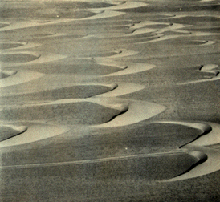
|
|
These crescentic dunes of coastal Peru are migrating toward the left (photograph by John McCauley). |
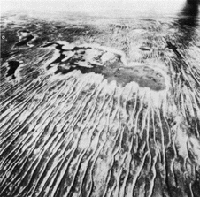
|
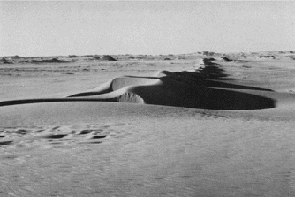
|
|
Linear dunes advance on small playas east of Lake Eyre in the Simpson Desert of central Australia (photograph by C. Twidale). |
Linear dunes in the western deserts of Egypt (photograph by Carol Breed). |
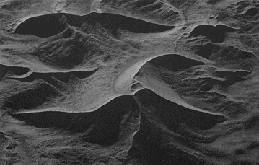
|
|
Star dunes, such as these of the Namib, indicate the winds that formed them blew from many directions (photograph by Georg Gerster). |
Oval or circular mounds that generally lack a slipface, dome dunes are rare and occur at the far upwind margins of sand seas.
U-shaped mounds of sand with convex noses trailed by elongated arms are parabolic dunes. Sometimes these dunes are called U-shaped, blowout, or hairpin dunes, and they are well known in coastal deserts. Unlike crescentic dunes, their crests point upwind. The elongated arms of parabolic dunes follow rather than lead because they have been fixed by vegetation, while the bulk of the sand in the dune migrates forward. The longest known parabolic dune has a trailing arm 12 kilometers long.
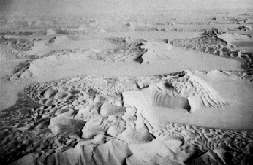
|
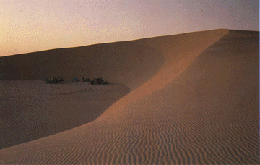
|
| Small crescentic dunes occur on the crests of these complex dome dunes of Saudi Arabia's Empty Quarter (photograph by Elwood Friesen). | Ripples and horns of this crescentic dune in Egypt indicate that the dune is moving right to left (photograph by John Olsen). |
All these dune types may occur in three forms: simple, compound, and complex.
Simple dunes are basic forms with a minimum number of slipfaces that define the
geometric type. Compound dunes are large dunes on which smaller dunes of similar
type and slipface orientation are superimposed, and complex dunes are
combinations of two or more dune types. A crescentic dune with a star dune
superimposed on its crest is the most common complex dune. Simple dunes represent
a wind regime that has not changed in intensity or direction since the formation
of the dune, while compound and complex dunes suggest that the intensity and
direction of the wind has changed.




